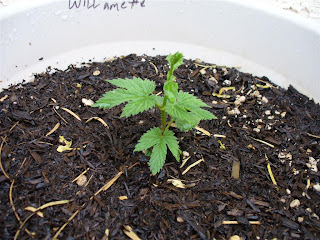Everyone the world round knows that the one thing you need to brew a good batch of beer is a good batch of hops. Especially of you like the good hoppy beers, like an Indian Pale Ale. My son-in-law has been brewing beer for a little while now and has been brewing some top notch American Ale and a few other varieties (including a stout I liked). He has quickly moved from bottling his beer to kegging it and trying a variety of brewing methods. The next logical step is to grow his own hops! (We're probably out of luck when he decides he'd like to start farming barley here in Tucson, but you never know.)
Hops is a rhizomatic plant, not unlike mint or strawberry in that sense--if you have ever grown either of those plants you'll know they can spread like crazy if you don't set some boundaries. For that reason it's pretty easy to propagate--you just cut off pieces of the rhizome and root it. Pretty soon you'll have a hop plant. I'm not saying hops doesn't require certain conditions--it does. It likes heat. It likes water. It likes sun. It likes well-drained soil. Water and well-drained soil aren't typical qualities of Tucson dirt. But you can mimic almost anything in a pot.
Freddie ordered up six rhizomes, two each of three varieties (I think--I could be wrong on the quantities & varieties!). Cascade, probably one of the most popular hops varieties used in brewing, was of course in the mix. He also ordered Willamette and Magnum varieties. There may have been another variety, but I'm not sure. Rather than try to grow them all himself, he divied them up--two at my house, two at his aunt's house, two at his house, etc. I received two rhizomes, Cascade and Willamette. I potted them in twelve inch pots with a well-draining soil mix on top of a base of volcanic rock for ensured drainage. Normally a hop plant can root up to fifteen feet, so I hope it doesn't get root bound in the pot. If it looks like that might happen, we can always get a larger pot, but it will simply be wider, not necessarily deeper. We could try to plant it in the ground, but it's much easier to control moisture within the confines of a pot.
It has been three weeks and I now have plants. The Willamette came up first and it is about three or four inches tall. The Cascade was a week or so behind the Willamette and it is only about an inch above the surface. Hops is a natural climber so we have decided to drop twine from the roofline and let the plants climb up that (after some initial training, of course). We haven't dropped the twine yet, but I'm thinking we'd better do it before it gets too hot out--I'm in no hurry to go shimmying around a tile roof when it's a hundred degrees out.
I'll be giving hops updates as it seems appropriate. We probably won't be harvesting any this year, though. If I understand it correctly, generally the first year is more about establishing the plant than it is about harvesting. We might get a few buds to work with. It would be cool if Freddie was able to harvest enough this year for at least one batch of beer. Maybe he'll be able to use his own home grown hops in his Belgium style wheat beer infused with his own home grown lavendar!



